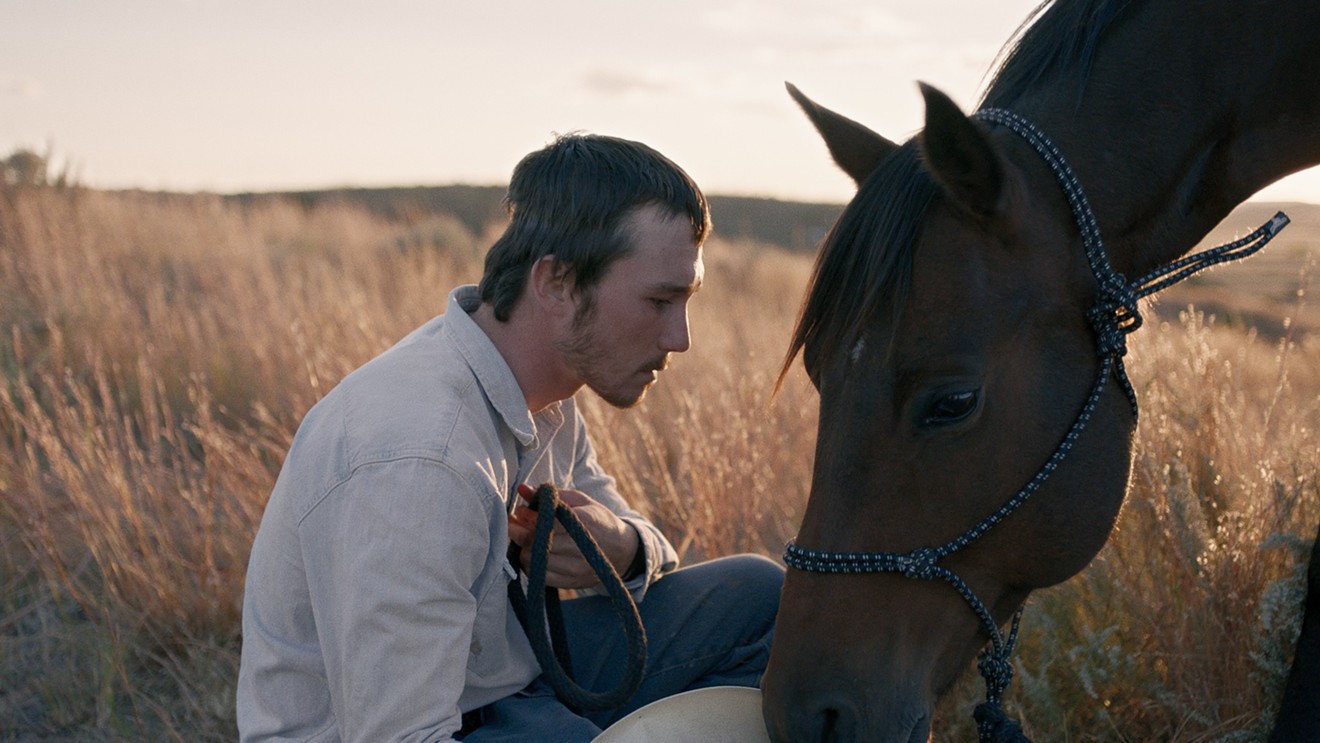“You’re on big old Gus again. Loping across the prairie, feel the wind on your face, chasing them cows out of the trees. You excited? You bet, brother.” A horseman says this to another near the end of Chloe Zhao’s The Rider, the dreamy vision full of both hope and melancholy. For the young cowboys at the heart of Zhao’s film, mounting a horse and galloping across a field represents more than just freedom — it becomes a communion with the past and the future, allowing these riders to imagine and inhabit their best selves. And there’s the rub: The movie’s about what happens when you can’t ride anymore. These lines are spoken in an antiseptic hospital room, by one broken boy to another.
Shot among real Sioux cowboys in South Dakota’s Pine Ridge Reservation, many of them essentially playing themselves, Zhao’s picture follows a young rodeo hotshot who’s been sidelined by a grave injury, the result of a ghastly fall off a horse. Told that he might die if he ever attempts to ride again, Brady (played by real-life rodeo star Brady Jandreau, whose own life and career-ending injury inspired the film) wrestles with a future devoid of the one activity that gives him meaning. His family — which consists of his prickly, gambling-addict dad and his autistic sister (also playing themselves) — is about to be evicted from its small ranch home. Brady is fenced in poverty and desperation, as well as reminders of his former life: friends, colleagues, fans and a seemingly endless supply of YouTube videos.
He’s also surrounded by horses and fields. This young man has an almost spiritual relationship to the creatures and the land. In one longish shot, we watch as he approaches a supposedly untamable animal — “a horse that’s had nobody on his back before” — and, applying subtle pressure and guiding it in small circles, actually quiets the beast down. It’s symbiotic: As the horse softens, so, too, does the man. And when he is able to sneak in a ride — those brief, stolen instances when he can hop on a horse and blissfully charge across the plain — something changes in Brady, and in the world around him. The desolation and destitution seem to fade away. After each ride, Zhao shows her protagonist looking off into the distance. Much of The Rider has been shot at magic hour, and in these moments, it’s hard not to be overcome by the splendor of the landscape. The land stretches away forever in great meadows, and the horizon finally seems to glow again with newness and possibility.
Movies that blend narrative and documentary — whether in the form of one of those unclassifiables we now see regularly at Sundance or a studio comedy with celebrity cameos — often find ways to cordon off the fiction from the real life, winking at us when the boundaries have been crossed. Intentionally or not, such films become about the blurring of these lines. That has its place. But Zhao takes a different approach, privileging the narrative, the poetry and the realism in equal measure, blending them together to create something astonishingly powerful.
That Brady is a real horseman becomes evident when we see him interact with his non-human scene partners. And the film opens with the young man taking staples out of his horrifically scarred-up, bandaged head — a scene so visceral, I had to turn away. Some of The Rider’s most touching moments come when Brady visits his paraplegic best friend and fellow rodeo casualty, Lane Scott, who also plays himself. Brady helps Lane — whose injuries are infinitely more severe than his — with physical therapy, as they fake-ride on hospital equipment, dreaming of the open fields.
Such authenticity of milieu and action helps bolster the film’s more philosophical and psychological elements. Barely in his early 20s, Brady is caught between the duties of manhood and a child’s helplessness. When he argues with his tough-guy father, their tense confrontations have a slow-burning danger to them. They’re not melodramatic movie shouting matches, amped up for impact; the rage and resentment are restrained, the way it tends to happen in the real world.
But perhaps more important is what they’re arguing about, which is the dilemma at the heart of the film. Dad has instilled a macho code in his son, but now wants him to stand down from the fight of his life. “What happened to cowboy up, grit your teeth? What happened to all that, dad?” Brady asks, and the older man has no response. Neither do we; the movies — especially Westerns — traffic in myths of physical bravery and freedom. The Rider is, in part, a deconstruction of such myths. When Zhao shows us what riding means to Brady — the spiritual and emotional place it holds in his life — she partly buys into the myth, but then she turns around and interrogates it. Can we be whole again, she asks, even when we must deny ourselves the thing that makes us what we are?
[
{
"name": "GPT - Billboard - Slot Inline - Content - Labeled - No Desktop",
"component": "16971022",
"insertPoint": "2",
"requiredCountToDisplay": "2"
},{
"name": "Editor Picks",
"component": "15769925",
"insertPoint": "4",
"requiredCountToDisplay": "1"
},{
"name": "Inline Links",
"component": "16575154",
"insertPoint": "8th",
"startingPoint": 8,
"requiredCountToDisplay": "7",
"maxInsertions": 25
},{
"name": "GPT - Rectangle 2x - Slot Auto-select - Labeled",
"component": "15782206",
"insertPoint": "8th",
"startingPoint": 8,
"requiredCountToDisplay": "7",
"maxInsertions": 25
},{
"name": "Inline Links",
"component": "16575154",
"insertPoint": "8th",
"startingPoint": 12,
"requiredCountToDisplay": "11",
"maxInsertions": 25
},{
"name": "GPT - Leaderboard to Tower - Slot Auto-select - Labeled",
"component": "15782207",
"insertPoint": "8th",
"startingPoint": 12,
"requiredCountToDisplay": "11",
"maxInsertions": 25
}
]











